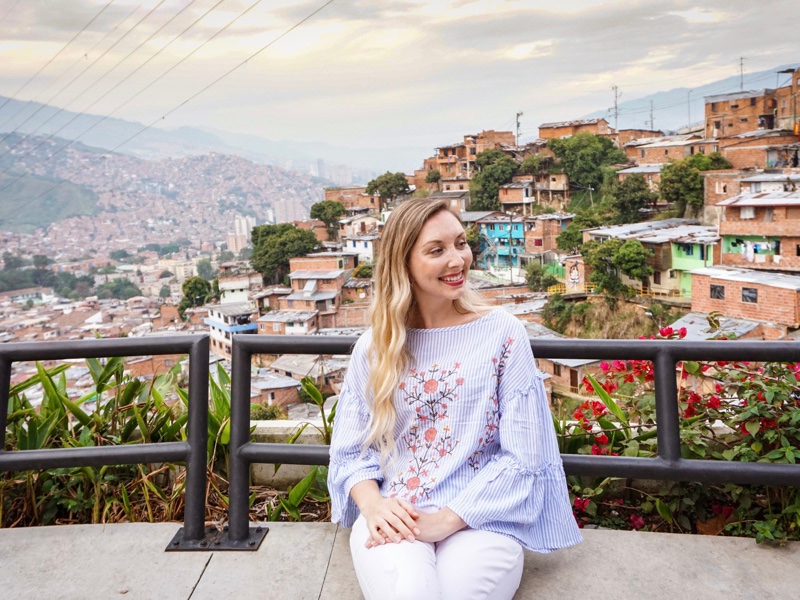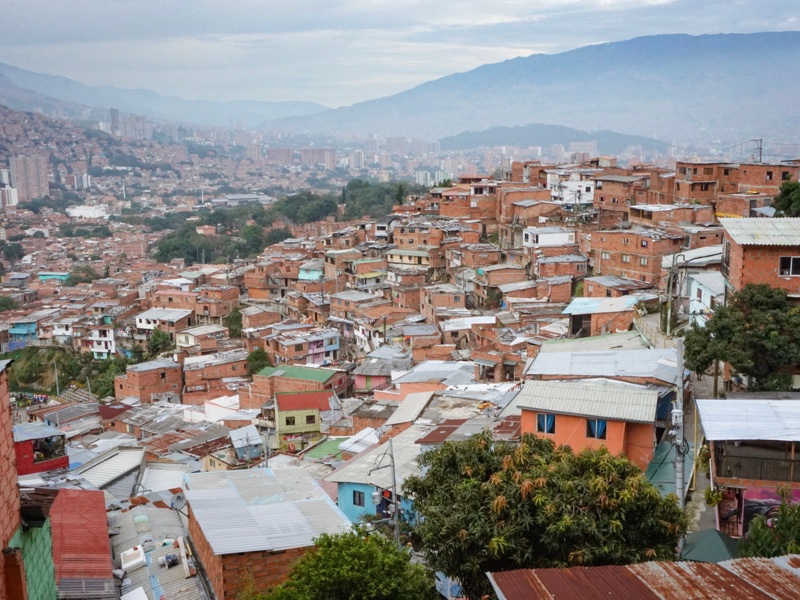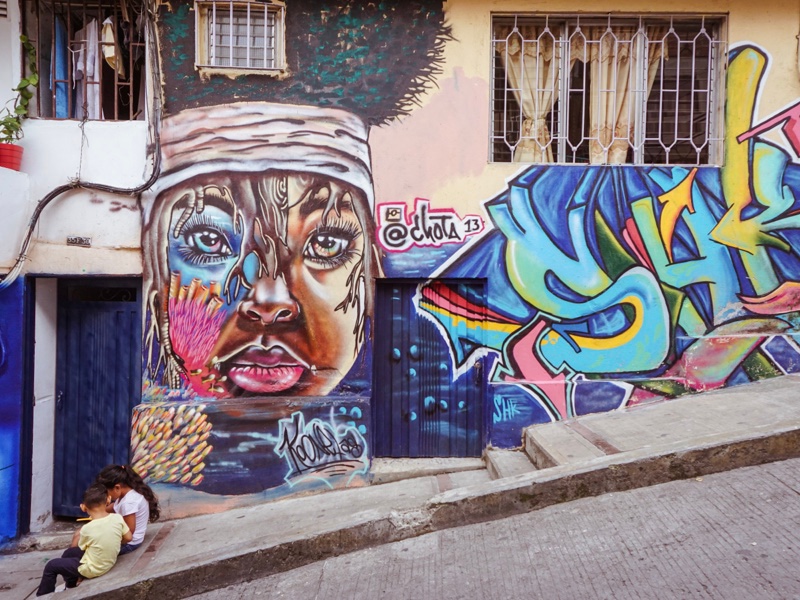In planning my itinerary for Colombia, I almost made the mistake of leaving out Medellín. I really knew very little about the city and wasn’t sure it would be a highlight for me. I was wrong.
Known as the City of Eternal Spring, I was totally unprepared for what a beautiful and scenic city Medellín really is. I’m not sure I’ve ever seen a more lush and green mountainous landscape surrounding a large city. Sitting at almost 5,000 feet, Medellín maintains a warm temperate climate all year round with plenty of rainfall.
What surprised me most about my visit to Medellín, was the neighborhood of Comuna 13. I had never even heard of it until planning what to do and see in the city, and I quickly realized it was an attraction I couldn’t miss.

To see Comuna 13, I hired a private guide for the day who was a lifelong Medellín local. When we arrived at Comuna 13, it was like he was visiting family everywhere we went, introducing me to shop owners and artists on the street. Backslaps and fist bumps abounded.
I’ve never seen a place quite like Comuna 13. To say I was mind blown is an understatement. Medellín is a sprawling metropolis; the second largest city in Colombia. But Comuna 13 felt like a small urban community for the arts – a bustling oasis of creativity perched on the hillside overlooking the skyscrapers of this massive city.
It wasn’t always this way. Comuna 13 was once the epicenter of one of the most dangerous cities in the world in the 1980s and 90s. The community perched on the steep hillside was detrimentally isolated from the rest of the city below. Homes were poorly constructed with little infrastructure or access to resources like clean water and electricity making residents vulnerable.

It wasn’t until 2006 that the mayor of Medellín led the transformation of Comuna 13 with massive investments in infrastructure to improve the quality of life for residents. An appeal to tourists was never the intention, but rather to integrate the cut off neighborhoods with the rest of the city to provide better opportunities for the residents and reduce crime.
A cable car to connect residents to the rest of the city was built in 2008 saving them massive amounts of time on their commutes and opening up opportunities with convenient transportation. Unlike typical cable cars for touristy purposes, the cable cars in Medellín were designed with a transformation of the quality of life for the residents in mind. These innovative cable cars were hugely instrumental in bringing the city together and providing a symbol of change and hope.
A library park was built to provide access to computers, literature, and outdoor green spaces. Then in 2011 came the first of its kind – a series of covered, outdoor escalators in the heart of Comuna 13. These escalators saved residents from having to climb roughly 350 steep steps, additionally reducing their commute time and making less-mobile residents able to come and go safely. A viaduct was also built through the community where motorcycles and pedestrians can safely travel. In 2013, Medellín was named “Most Innovative City in the World”.

One of my favorite parts of Comuna 13 is undoubtedly the street art. It dominates every part of the neighborhood with its vibrant colors, expressions of what the residents have been through, and the hope and resilience they have today. The city invited local artists to adorn the neighborhood with art and graffiti in a celebration of the completion of the escalators.
With these unique innovations came tourists. Visitors started coming to Comuna 13 to see the creative solutions the city had come up with for its residents and the world-famous urban development projects. They marveled at the street art. Before long, locals were taking control of their neighborhood with an entrepreneurial spirit. They started fruit stands, book shops, cafes, souvenir shops, and galleries out of their homes. Hip hop and breakdance performances emerged in the streets. Today, Comuna 13 welcomes tens of thousands of visitors each week bringing income to the community.
As I rode the escalators with my guide, eating my frozen mango treat, I wondered how residents feel about the intrusiveness of tourists in their community and how different this must be from years prior. The new normal is not perfect, as living costs have risen and privacy has gone down. But overall, the residents of Comuna 13 can safely walk their neighborhood and easily get to the city center. Equally as important, is they have built a community to be proud of. The local culture is offered up with an energy that tells a story of survival and optimism.

Children scramble after footballs in the street laughing as we go by and the sound of music and people cheering for break-dancers drifts through the area. I imagine most people would choose this over the sound of gunfire. I marvel at every piece of art I walk by, knowing I can never grasp the pain and suffering these people experienced to inspire these creations. Many residents there today lived through decades of violence and remember the fear and trauma vividly.
No city is perfect, but I was incredibly moved to witness the strength and pride of the people in Comuna 13 and Medellín. They’ve managed to honor a traumatic past and turn it into something beautiful and hopeful. The stark contrast of past and present make the vibrancy of Comuna 13 all the more inspiring. Through a willingness to change, a city brought to the brink of collapse has been transformed. Now that is a story worth telling.






















